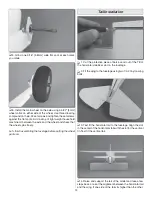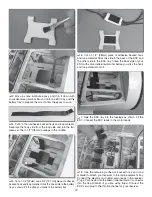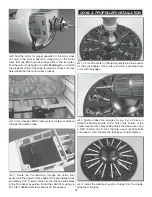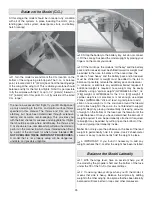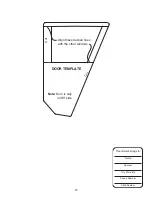
24
FULL
THROTTLE
RUDDER
MOVES
RIGHT
ELEVATOR
MOVES DOWN
RIGHT AILERON
MOVES UP
LEFT AILERON
MOVES DOWN
4-CHANNEL RADIO SET UP
(STANDARD MODE 2)
❏
3. Make certain that the control surfaces and the throttle
respond in the correct direction as shown in the diagram.
If any of the controls respond in the wrong direction, use
the servo reversing in the transmitter to reverse the servos
connected to those controls. Be certain the control surfaces
have remained centered. Adjust if necessary.
Set the Control Throws
To ensure a successful first flight, fly your model set up only
according to the C.G. and control surface throws specified in
this manual. The throws and C.G. are not arbitrary, but have
been determined through extensive testing and accurate
record-keeping. This provides you with the best chance for
success and enjoyable first flights that should be surprise-
free. Additionally, the throws and C.G. shown are true, real
data which will allow the model to perform in the manner in
which it was intended when flown by a pilot of the skill level
for which it was intended. DO NOT OVERLOOK THESE
IMPORTANT PROCEDURES. A model that is not properly
setup may be unstable and possibly unflyable.
The building steps earlier in this manual that show the
mechanical setup for the elevator, rudder, and aileron
linkages show you the best way to configure the linkages to
achieve the proper throws using Futaba servos and a Futaba
radio system. If you are using a different radio system or
you cannot achieve the proper control throws using our
suggested linkage configuration, you may have to install the
pushrods in different holes on the servo arms or the control
horns. Keep in mind that changing the throws mechanically
is preferred to changing them using your radio’s end-point
adjustment. End points can be used to “fine-tune” to get the
proper throws.
❏
1. Use a Great Planes AccuThrow
™
gauge, a ruler, or an
inclinometer to accurately measure and set the control throw
of each control surface as indicated in the chart that follows.
If your radio does not have dual rates, we recommend
setting the throws at the LOW rate setting. Under normal
circumstances, and if you have both high and low rates set
up, you will perform takeoffs and landings using high rate
aileron and elevator and then switch to low rates for flight.
With this model, we recommend using high rate rudder only
during taxi on the ground. Switch to low rate rudder before
you initiate your takeoff.
❏
2. When setting up flaps for this model, please use only
the amount that we suggest below. This is the right amount
required to slow the model down without causing it to balloon
up excessively.
These are the recommended control surface throws:
ELEV
A
T
OR
HIGH RATE
LOW RATE
5/8"
[16 mm]
12°
Up
5/8"
[16 mm]
12°
Down
1/2"
[13 mm]
9°
Up
1/2"
[13 mm]
9°
Down
7/8"
[22 mm]
22°
Up
7/8"
[22 mm]
22°
Down
5/8"
[16 mm]
15°
Up
5/8"
[16 mm]
15°
11/16"
[17 mm]
16°
Down
3/4"
[19 mm]
13°
Right
3/4"
[19 mm]
13°
Left
5/8"
[16 mm]
11°
Right
5/8"
[16 mm]
11°
Left
R
UDDER
AILER
ONS
FLAPS





